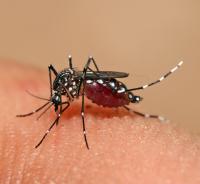CHANS research will help reduce risk of dengue fever
Nov. 13, 2013
A study by an international team of researchers led by CHANS-Net member Anna M. Stewart Ibarra of the Center for Global Health and Translational Science (CGHATS) at SUNY Upstate Medical University is giving public health officials information that will help decrease the risk of dengue, a life-threatening mosquito-borne viral disease that is one of the fastest spreading tropical diseases globally.
Stewart Ibarra's team discovered that certain household risk factors, combined with changes in rainfall and minimum temperature, could be used to predict the presence and abundance of the mosquito that transmits dengue fever.
The paper, "Dengue Vector Dynamics (Aedes aegypti) Influenced by Climate and Social Factors in Ecuador: Implications for Targeted Control," was published Nov. 12 in PLOS ONE.
Dengue fever is a public health threat throughout the tropics and now emerging as a threat in Florida and along the Texas border. The disease is transmitted to people primarily by the Aedes aegypti mosquito, which reproduces in standing water in and around people's homes. The virus cannot be spread directly person-to-person. There is no vaccine available, though trials are ongoing.
Until a vaccine becomes available, controlling the mosquitoes is the only way to control the disease.
“The findings from this study will help public health officials develop mosquito control campaigns that target high-risk households and mosquito habitats in each season,” said Stewart Ibarra.
The researchers conducted the study from 2010 to 2011 in Machala, a city on the southern coast of Ecuador, where dengue is prevalent. They monitored mosquito populations and conducted household surveys to identify dengue risk factors, such as water storage practices, access to piped water and knowledge and perceptions of dengue. They also looked at local climate factors, since previous studies by Stewart Ibarra and colleagues had demonstrated that climate and sea surface temperature (El Niño-Southern Oscillation) influence dengue transmission in this region.
"Our findings can help reduce the burden of dengue in this particular region by conducting focused interventions that target high-risk households and containers in each season and by developing predictive models using climate and non-climate information,” said Stewart Ibarra.
The results also have contributed to the development of a multi-year investigation of climate, the dengue virus, and Aedes aegypti in the same region, led by Stewart Ibarra and Timothy Endy.
Other members of the research team are: CHANS-Net member Sadie J. Ryan, of SUNY College of Environmental Science and Forestry; Efrain Beltran and Mercy Silva, of the National Service for the Control of Vector-Borne Diseases, Ministry of Health, Ecuador; Raul Mejia, of the National Institute of Meteorology and Hydrology, Ecuador; and Angel Muñoz, of the International Research Institute of Climate and Society, Columbia University.







